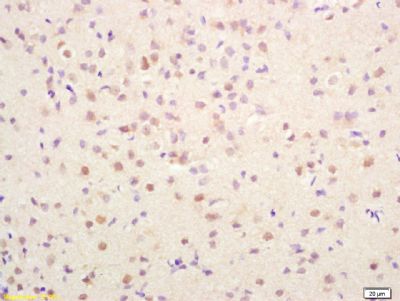
AMPKγ2/PRKAG2,腺苷单磷酸活化蛋白激酶γ2抗体
产品名称: AMPKγ2/PRKAG2,腺苷单磷酸活化蛋白激酶γ2抗体
英文名称: Anti-AMPKγ2/PRKAG2 antibody
产品编号: HZ-9446R
产品价格: null
产品产地: 中国/美国
品牌商标: HZbscience
更新时间: 2023-08-17T10:24:20
使用范围: WB,ELISA,IHC-P,IHC-F,IF
- 联系人 : 鲍丽雯
- 地址 : 上海市闵行区闵北路88弄1-30号第22幢AQ136室
- 邮编 : 200612
- 所在区域 : 上海
- 电话 : 139****0749 点击查看
- 传真 : 点击查看
- 邮箱 : www.shzbio.net
- 二维码 : 点击查看
AMPKγ2/PRKAG2,腺苷单磷酸活化蛋白激酶γ2抗体
产品编号HZ-9446R
英文名称AMPKγ2/PRKAG2
中文名称腺苷单磷酸活化蛋白激酶γ2抗体
别 名5''-AMP-activated protein kinase subunit gamma-2; AAKG; AAKG2; AAKG2_HUMAN; AMPK gamma2; AMPK subunit gamma 2; AMPK subunit gamma-2; CMH6; H91620p; Prkag2; Protein kinase AMP activated gamma 2 non catalytic subunit; WPWS.
说 明 书0.1ml 0.2ml
研究领域肿瘤 心血管 细胞生物 信号转导
抗体来源Rabbit
克隆类型Polyclonal
交叉反应 Human, Mouse, Rat, Chicken, Dog, Pig, Cow, Horse,
AMPKγ2/PRKAG2,腺苷单磷酸活化蛋白激酶γ2抗体产品应用WB=1:100-500 ELISA=1:500-1000 IHC-P=1:100-500 IHC-F=1:100-500 ICC=1:100-500 IF=1:50-200 (石蜡切片需做抗原修复)
not yet tested in other applications.
optimal dilutions/concentrations should be determined by the end user.
分 子 量63kDa
细胞定位细胞核 细胞浆
性 状Lyophilized or Liquid
浓 度1mg/1ml
免 疫 原KLH conjugated synthetic peptide derived from human PRKAG2/AMPKγ2
亚 型IgG
纯化方法affinity purified by Protein A
储 存 液0.01M TBS(pH7.4) with 1% BSA, 0.03% Proclin300 and 50% Glycerol.
保存条件Store at -20 °C for one year. Avoid repeated freeze/thaw cycles. The lyophilized antibody is stable at room temperature for at least one month and for greater than a year when kept at -20°C. When reconstituted in sterile pH 7.4 0.01M PBS or diluent of antibody the antibody is stable for at least two weeks at 2-4 °C.
AMPKγ2/PRKAG2,腺苷单磷酸活化蛋白激酶γ2抗体PubMedPubMed
产品介绍background:
AMPK is a heterotrimeric complex comprising a catalytic a subunit and regulatory b and g subunits. It protects cells from stresses that cause ATP depletion by switching off ATP-consuming biosynthetic pathways. AMPK is activated by high AMP and low ATP through a mechanism involving allosteric regulation, promotion of phosphorylation by an upstream protein kinase known as AMPK kinase and inhibition of dephosphorylation. Activated AMPK can phosphorylate and regulate in vivo hydroxy-methylglutaryl-CoA reductase and acetyl-CoA carboxylase, which are key regulatory enzymes of sterol synthesis and fatty acid synthesis, respectively. The human AMPKa1 and AMPKa2 genes encode 548 amino acid and 552 amino acid proteins, respectively. Human AMPKb1 encodes a 271 amino acid protein and human AMPKb2 encodes a 272 amino acid protein. The human AMPKg1 gene encodes a 331 amino acid protein. Human AMPKg2 and AMPKg3, which are 569 and 492 amino acid proteins, respectively, contain unique N-terminal domains and may participate directly in the binding of AMP within the AMPK complex.
Function:
AMP/ATP-binding subunit of AMP-activated protein kinase (AMPK), an energy sensor protein kinase that plays a key role in regulating cellular energy metabolism. In response to reduction of intracellular ATP levels, AMPK activates energy-producing pathways and inhibits energy-consuming processes: inhibits protein, carbohydrate and lipid biosynthesis, as well as cell growth and proliferation. AMPK acts via direct phosphorylation of metabolic enzymes, and by longer-term effects via phosphorylation of transcription regulators. Also acts as a regulator of cellular polarity by remodeling the actin cytoskeleton; probably by indirectly activating myosin. Gamma non-catalytic subunit mediates binding to AMP, ADP and ATP, leading to activate or inhibit AMPK: AMP-binding results in allosteric activation of alpha catalytic subunit (PRKAA1 or PRKAA2) both by inducing phosphorylation and preventing dephosphorylation of catalytic subunits. ADP also stimulates phosphorylation, without stimulating already phosphorylated catalytic subunit. ATP promotes dephosphorylation of catalytic subunit, rendering the AMPK enzyme inactive.
AMPKγ2/PRKAG2,腺苷单磷酸活化蛋白激酶γ2抗体Subunit:
AMPK is a heterotrimer of an alpha catalytic subunit (PRKAA1 or PRKAA2), a beta (PRKAB1 or PRKAB2) and a gamma non-catalytic subunits (PRKAG1, PRKAG2 or PRKAG3). Interacts with FNIP1 and FNIP2.
Subcellular Location:
Cytoplasmic and Nuclear
Tissue Specificity:
Isoform B is ubiquitously expressed except in liver and thymus. The highest level is detected in heart with abundant expression in placenta and testis.
Post-translational modifications:
Phosphorylated by ULK1; leading to negatively regulate AMPK activity and suggesting the existence of a regulatory feedback loop between ULK1 and AMPK. Phosphorylated upon DNA damage, probably by ATM or ATR.
DISEASE:
Defects in PRKAG2 are the cause of cardiomyopathy, familial hypertrophic type 6 (CMH6) [MIM:600858]. A hereditary heart disorder characterized by ventricular hypertrophy, which is usually asymmetric and often involves the interventricular septum. The symptoms include dyspnea, syncope, collapse, palpitations, and chest pain. They can be readily provoked by exercise. The disorder has inter- and intrafamilial variability ranging from benign to malignant forms with high risk of cardiac failure and sudden cardiac death. CMH6 patients present Wolff-Parkinson-White ventricular preexcitation, enlarged myocytes without myofiber disarray, and glycogen-containing cytosolic vacuoles within cardiomyocytes.
Defects in PRKAG2 are a cause of glycogen storage disease of heart lethal congenital (GSDH) [MIM:261740]; also known as phosphorylase kinase deficiency of heart or congenital nonlysosomal cardiac glycogenosis. GSDH is a rare disease which leads to death within a few weeks to a few months after birth, through heart failure and respiratory compromise.
Similarity:
Belongs to the 5'-AMP-activated protein kinase gamma subunit family.
Contains 4 CBS domains.
Gene ID:
51422
Database links:
Entrez Gene: 51422 Human
Entrez Gene: 108099 Mouse
Entrez Gene: 373545 Rat
Omim: 602743 Human
SwissProt: Q9UGJ0 Human
SwissProt: Q91WG5 Mouse
Unigene: 647072 Human
Unigene: 33649 Mouse
AMPKγ2/PRKAG2,腺苷单磷酸活化蛋白激酶γ2抗体Important Note:
This product as supplied is intended for research use only, not for use in human, therapeutic or diagnostic applications.


